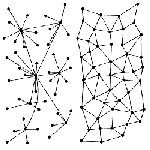Wireless sensor networks will soon become as important as the Internet. Just as the Internet allows access to digital information anywhere, sensor networks will provide vast arrays of real-time, remote interaction with the physical world. The industrial automation business will be generating significant growth in this new arena.
Smart, wireless networked sensors will soon be everywhere around us, collecting and processing vast amounts data – from air quality and traffic conditions, to weather conditions and tidal flows. And this means not just monitoring a few isolated sensors, but literally tens of thousands of intelligent sensor nodes which provide not merely local measurements, but overall patterns of change.
Within the next few years, this significant new technology will help run factories, optimize widely spread processes, monitor the weather, detect the spread of toxic gases in chemical spills, and even provide precious extra time in advance of tornados and earthquakes.
Today large, expensive and dumb
– tomorrow tiny, cheap and smart
Sensors are already everywhere. But most sensors used today are large, expensive and dumb – they lack the intelligence to analyze or act on their measurements, simply providing isolated measurements for remote processing.
Soon, MEMS and Nanotechnology will yield tiny, low cost, low power sensors. Tiny is important because they can be scattered around unobtrusively to measure just about everything that you can imagine. Low power because they won't need to carry a large battery and may even be solar-powered. Low-cost because the numbers required will be enormous.
Several new companies are already producing ultra low-power, postage stamp-sized smart sensors which yielding good results in a variety of applications. But the thumbnail size is still only an interim stage – soon integrated sensors and silicon will yield microscopic components which can be scattered around like “smart dust”.
Combination of three hot technologies
There are 3 basic technologies involved in smart sensor networks:
- Micro miniature, ultra-low-power sensors. Today these are usually MEMS, structures that are fabricated like silicon integrated circuits. With the advances of Nanotechnology, atomic-scale sensors will come on the scene.
- Embedded silicon chips, wireless transceivers and firmware for P2P communications & self-organizing systems. While the individual nodes are relatively fragile and communicate over only small distances, the complete networks are robust, with communication through multiple redundant paths.
- Software for communications, control and optimization for thousands of nodes.
Together, these new developments are bringing intelligent wireless sensor networks that can be spread over wide areas. The vast intelligent arrays can yield individual hot-spots instantly for real-time analysis. In addition, it provides information to facilitate overall pattern recognition analysis in ways that were previously unimaginable.
Smart wireless sensor networks are one of the first real-world examples of "pervasive" computing – small, smart, cheap sensing and computing devices that will permeate the environment.
Sensor networks counter terror threats
Once tiny, low power sensors are available and the measurements are communicated and coordinated through peer-to-peer wireless links, the technology moves to whole new software arenas: pattern-recognition, heuristic analysis, self-organizing systems, and complexity science.
The funding required to develop this significant new technology synthesis is becoming available to fill important needs. Against the backdrop of the war on terrorism, work is progressing on a nationwide sensor network that someday could provide a real-time early-warning system for a wide array of chemical, biological and nuclear threats across the US.
With a $1 billion budget in 2004, the US Department of Homeland Security is doing a significant amount of new development, plus coordinating the efforts of key scientists at national labs. The core technology relates to materials, sensors, networks and chips. Field trials of prototype sensor networks are already starting.
MEMS and Nanotech will be used to create several low-cost, highly accurate biological and chemical sensors. On the networking front, peer-to-peer networks with multilevel security and quality-of-service guarantees will span wireless, wired and satellite links.
Applications
Within the next few years, these technology developments will impact industrial and commercial markets, bringing huge new opportunities.
Immediate markets include industrial automation and process control, unattended sensors and real-time monitoring over wide areas, utilities (automated meter reading, building automation (heating and cooling patterns to provide optimized control).
Within the next few years, distributed sensing and computing will be everywhere – homes, offices, factories, automobiles, shopping centers, super-markets, farms, forests, rivers and lakes. The fields of accurate weather prediction, storm, earthquake and tornado warning, will be revolutionized through widespread wireless sensors.
In a flat or declining industrial automation marketplace, expect big growth from this arena. Get your company involved. Find ways to utilize intelligent sensor networks with your products or applications.
 Wireless sensor networks will soon become as important as the Internet. Just as the Internet allows access to digital information anywhere, sensor networks will provide vast arrays of real-time, remote interaction with the physical world. The industrial automation business will be generating significant growth in this new arena.
Wireless sensor networks will soon become as important as the Internet. Just as the Internet allows access to digital information anywhere, sensor networks will provide vast arrays of real-time, remote interaction with the physical world. The industrial automation business will be generating significant growth in this new arena.

 Return to JimPinto.com HomePage
Return to JimPinto.com HomePage

